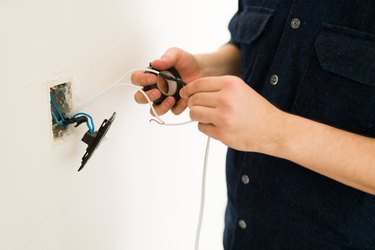
Electrical tape may not look like much, but it's quite important on some electrical connections. This specialty tape keeps the current from flowing between nearby wires, ultimately preventing electrical shorts or even fires. It's also fireproof and resistant to heat, which is important when used on wire connections nearly touching flammable materials, such as wood wall studs.
Electrical tape also keeps the otherwise exposed areas of wire clean and protects them from moisture. Though it's most common in black, electrical tape in other colors is handy for marking connections to indicate which wires are which, such as ground or low-voltage wires.
Video of the Day
Video of the Day
Here are the reasons to use electrical tape to insulate wiring, make minor repairs to electrical cords, and color-code wired connections.
Electrical Tape's Stretchy Importance
Unlike most adhesive tapes, electrical tape is designed to stretch or elongate a bit before it breaks. When stretched and then wrapped around wire, it shrinks back down, constricting around the wire for a tight fit. This snug fit is what blocks moisture, dust, or any form of contaminant from reaching the bare wire. Low-quality electrical tape might not elongate much, which means it won't create as good a barrier around the tape as one that's far more elastic.
Test any electrical tape's elongation ability by stretching out a piece that's 4 or 5 inches long and wrapping it around your finger a few times. A good tape constricts around your finger enough that you'll feel it happening.
When and Why Electrical Tape Matters
Electrical tape comes in handy even if you aren't connecting any wires. It's useful for minor electrical cord repairs, such as when the outer covering cracks on an outdoor extension cord, revealing the coated wires inside. Use electrical tape to repair an electrical cord only if the wires inside are intact and not frayed at all. Ideally, it's best to use it before a major split happens in the outer covering on the electrical cord. Stretch the tape and then wrap it around the affected area, starting ahead of the split in the outer coating and continuing a little beyond it. Each winding of tape should overlap half the previous layer to ensure the tape stays put.
Though it's often seen on old wiring, electrical tape shouldn't be used to connect household wiring, such as within a ceiling light. Cap-style wire connectors that twist onto the wire ends are a much better choice for protecting the connection safely. In some cases, electrical tape comes in handy for wrapping around the wire connectors and parts of the coated wiring to protect all of it from moisture or contaminants and to manage the wires a bit better. Twist-on connectors, also called wire nuts, are sold in different sizes to fit different wires.
Electrical Tape for Color Coding
Color codes help electricians and even homeowners tell which wires are ground wires and which might be high or low voltage. In the United States, different tape colors usually carry the following meanings:
- White tape usually means the wire is neutral and of low voltage.
- Green tape indicates earth ground.
- Green- and yellow-striped tape means isolated ground.
- Gray tape means the wire is a neutral but has high voltage.
- Blue indicates low voltage with a neutral sheath.
For projects beyond typical residential wiring, other tape colors are also used to indicate the levels of voltage or the purpose of the wire.